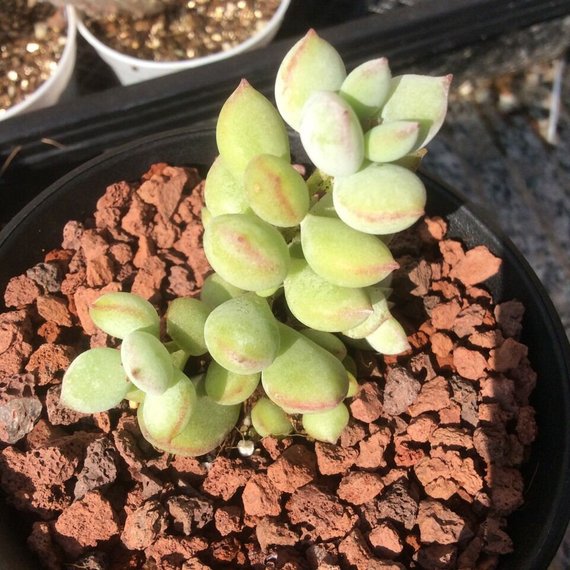Cotyledon pendens belongs to the Crassulaceae family, Sedum genus, and is a succulent plant. It is a small shrub with delicate and plump leaves that grow profusely, easily forming clusters in pots. It also has a sweet fragrance, resembling a light scent similar to lemon oil, which is very pleasant. Therefore, many people also call it "fragrant Cotyledon pendens." Under the sunlight, the fragrance of Cotyledon pendens becomes more intense, refreshing, and delightful. The leaves of Cotyledon pendens are oval-shaped with pointed tips, covered with a thin layer of white powder. The color of the leaves ranges from emerald green to yellowish-green, and they tend to cluster together. With sufficient light and significant temperature differences, the leaf tips and edges turn red. It has umbel-shaped conical inflorescences with tall flower clusters, and the tubular flowers hang down, blooming in orange-red color with five-lobed tips. It flowers in early summer.
Cotyledon pendens, a slender succulent, has very thin stems that have difficulty supporting its upward growth, so it tends to sprawl along the ground, displaying vigorous vitality. It easily fills a pot, forming a beautiful shape. Moreover, it is straightforward to care for. Placed in a well-ventilated, sunny balcony, watered thoroughly during the growing season, it responds quickly, showing immediate plumpness after watering.
For soil mixtures, a combination of peat, vermiculite, and perlite is suitable. During the summer dormancy period, provide shade and ventilation while controlling watering. The colors become more attractive and charming in autumn and winter, with red edges and beautiful leaf shapes, making it highly ornamental.
The main growing seasons for Cotyledon pendens are spring, autumn, and early winter, during which it requires ample sunlight and moderate watering (allowing the soil to dry slightly between waterings). Prolonged lack of sunlight and excessive watering can lead to elongation, with leaves turning green and becoming thin. Cotyledon pendens exhibits brief dormancy during the hot summer, when it is prone to black rot and leaf drop. Proper shading or placement in a cool, ventilated area is necessary during the summer.
Cotyledon pendens has particularly short leaf stems, making leaf cuttings challenging, so propagation is generally done through stem cuttings. Semi-woody branches or top shoots are cut and allowed to dry before being inserted into sterile substrate for propagation.
Firstly, ensure loose and fertile soil and use large, breathable pots. When planting Cotyledon pendens, the soil mixture should be loose and breathable, typically a mixture of peat and granular soil in a ratio of 7:3. Too high a content of granules will result in small, slender leaves and slower growth. Cotyledon pendens grows rapidly, so adding some slow-release granular fertilizer to the soil mixture ensures sufficient nutrients.
Choose a large pot, preferably a wide and tall one, to provide ample space for the roots to grow, facilitating pot bursting. Additionally, the pot material should be breathable, with drainage holes.
Secondly, maintain suitable temperature and adequate moisture. The dormancy period of Cotyledon pendens is not particularly pronounced; as long as the temperature remains between 0°C and 30°C and it receives regular watering, it can continue to grow. When the temperature exceeds 30°C in summer, shading is necessary, and insulation should be provided during winter temperatures below 0°C to prevent frost damage. Between 10°C and 25°C, Cotyledon pendens grows remarkably fast, making bursting and branching effortless.
Most succulent plants dislike excessive watering, which can lead to elongation, greening, or even root rot and death. For Cotyledon pendens, insufficient watering can also affect its growth. During the seedling stage, keep the soil moderately moist to promote growth. When the plant reaches the desired size, watering intervals can be extended to stimulate water storage in the leaves, resulting in a plump appearance. Cotyledon pendens is not suitable for controlled cultivation; as long as it receives sufficient light, keeping the soil slightly moist is adequate. If the lower leaves become soft, water immediately to prevent prolonged dehydration.
Lastly, provide ample sunlight and proper pruning. Adequate sunlight not only induces Cotyledon pendens to flower but also effectively limits elongation. During maintenance, apart from shading and ventilation during the hot summer, ensure sufficient sunlight throughout the other seasons. Especially in autumn and winter, more sunlight enhances leaf transparency, and the red edges become more prominent. Moreover, sufficient sunlight enhances fragrance emission and promotes flowering. The flowers of Cotyledon pendens, resembling red lanterns, are highly ornamental.
Cotyledon pendens grows rapidly and continuously produces side branches. Without proper pruning, it may become overgrown and tangled, affecting ventilation and resulting in slender, sparse branches and leaves, diminishing its aesthetic appeal. Trimmed branches can be used for cuttings to propagate new plants. While pruning, ensure adequate fertilization to provide sufficient nutrients. Liquid fertilizer mixed with water or slow-release fertilizer can be applied. With ample sunlight, proper pruning, and appropriate fertilization, Cotyledon pendens can grow quickly, plump, and beautiful.
Cotyledon pendens is robust, easy to care for, fragrant, and blooms profusely. When in good condition, its leaves become transparent with red tips, making it a rare and excellent variety among succulents. With the right care, it becomes plumper and more beautiful, making it suitable for novice cultivation.
